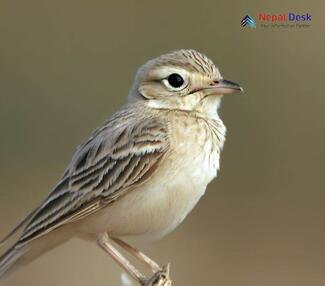The world of birds is full of fascinating species, each with its unique characteristics and habits, and among them lies the Sand Lark (Alaudala raytal). This small passerine bird belonging to the lark family often goes unnoticed due to its humble appearance, but it has some distinctive qualities that make it a species worthy of admiration. In this article, we'll explore the taxonomy, physical features, habitat, diet of the Sand Lark, and its noteworthy presence in Nepal.
Taxonomy: A Member of the Alaudidae Family
The scientific name of the Sand Lark is Alaudala raytal, placing it within the Alaudidae family. This family comprises over 90 species commonly known as larks, including Skylarks and Horned Larks. The genus Alaudala primarily inhabits parts of southern Asia and eastern Europe. Being closely related to Alaudala cheleensis (Asian Short-toed Lark), they share similar traits and behavior.
Physical Features: Small But Perfectly Formed
The Sand Lark is a small bird with a body length of approximately 12-14 cm and a wingspan that barely reaches 20 cm. It has an inconspicuous plumage comprising shades of brown and sandy colors with streaks on its upperparts, providing excellent camouflage in its natural habitat. Sand Larks also have a short crest on their heads which they raise during courtship or territorial displays. Their relatively short tail distinguishes them from other lark species.
Habitat and Diet
As indicated by its name, the Sand Lark thrives in sandy terrains such as riverbanks, dried water beds, or semi-arid zones with sparse vegetation. Found throughout parts of South Asia and the Middle East, their distribution range extends from Iran to India, and even stretches into northern Africa.
The Sand Lark's diet predominantly consists of invertebrates such as insects, spiders, and larvae. They employ a method of foraging in which they actively search for prey on the ground by walking or running in their typical habitat. During the breeding season and while feeding their young, Sand Larks may consume more insects to meet the nutritional requirements of their offspring.
Presence in Nepal: Birdwatcher's Delight
Nepal serves as a significant habitat range for Sand Larks, where they find solace in the country's diverse ecosystem. Birdwatchers in Nepal can spot them easily along riverbanks and floodplains during various nature walks or birdwatching tours, particularly in the Terai region. As a fascinating and lesser-known species within Nepal's rich avifauna, the Sand Lark provides ornithologists with a unique opportunity to study its behavior and ecology.
In conclusion, the Sand Lark (Alaudala raytal) may not possess flashy colors or enthralling songs like some other bird species but has captivating qualities that make it worth appreciating. The next time you find yourself exploring arid landscapes or embarking on a birdwatching expedition, keep an eye out for this small but charming bird hidden within sandy terrains.




